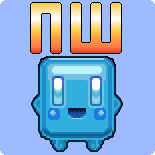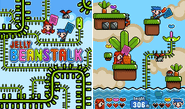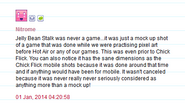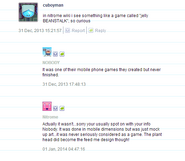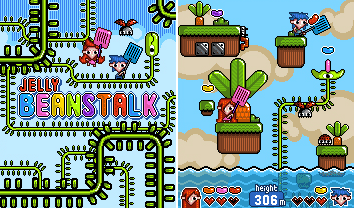
The two mock up images
Jelly Beanstalk is the name of mock up art[1] created by both Mat Annal[2] and Jon Annal[2][3] for a game idea[4][5]. The art was worked on by both brothers while they were practicing pixel art[1]. Although Jelly Beanstalk's art served as mock up art for a game idea, it was never planned for the game to actually go into production.[1]
The art for Jelly Beanstalk was created very early on in the career of Nitrome, before Hot Air[1] and even the original version of Chick Flick[1].
History[]
At a time prior to development beginning on the original version of Chick Flick, Mat[2] and Jon Annal[2] were practicing pixel art[6] and created an image for a mock-up game called Jelly Beanstalk. This was done at a time after the creation of Nitrome, but before work began on Chick Flick[1], so this would place Jelly Beanstalk's creation sometime in 2004 or the first three months of 2005[7] .
Years later, on July 27th 2006[8], Jon Annal uploaded this image to his Pixel Joint account[8]. The image was also uploaded to Deviant Art[9], some time in 2006.
Image[]
The Jelly Beanstalk image consists of two images side by side. The left image is what is presumably the game's starting screen, similar to that of a game menu screen that would read "Press <button> to start". This image consists of a cloud filled background that contains a long winding beanstalk whose body is all over the screen, at a point in the image the neck and head of the beanstalk is seen, with two jellybean hunters near its head, a ladybug above the hunters.
The words "Jelly Beanstalk" are seen below its neck. The next screenshot - the one on the right - is a gameplay screenshot. These two images contain a large amount of sprites which were later incorporated into other Nitrome games.
These images were uploaded to the sites Deviant Art[9] and Pixel Joint[8], with the provided blurb from Jon Annal[5]:
Mock-up shots for a mobile game called Jelly beanstalk. For all those who are interested the game concept goes as follows. There are two characters each wielding a giant flyswat. the object of the game is to feed the eating plant at the bottom of the screen by swatting the variouse [sic] bugs and insects which then fall into its open mouth. The plants neck then grows to make accessable [sic] platforms for players to progress jumping ledge to ledge/scrolling upwards. Different bugs make the neck grow in different diretions [sic], there are also time restrictions via the flooding water at bottom of level which steadly [sic] rises. The jellybeans left behind by squished bugs are for points and gain powerups for collecting all colours on a level. Now as some of you may be old enough to remember this is a bit of a slant on the classic rainbow islands, which is where I gathred [sic] a lot of my insperation [sic] from for this game. I did these a while ago but sadly never got round to develop the game...mebs oneday...sniff sniff.
Game information[]
Although Jelly Beanstalk was never planned to be developed into an actual game, Nitrome has provided some information on what would have been done with the game if it had ever been developed into a game.
Nitrome has stated that if the game were every to be developed, it would have most likely been a mobile phone game[10][11], this evident from Nitrome's interest in the mobile phone game market at the time, and how the two images are the same dimension as the screenshots of the original version of Chick Flick[10]. Jon Annal has stated that the game in general was heavily influenced by Rainbow Islands[12].
Gameplay[]
Based on what Jon Annal has stated about the game[5], Jelly Beanstalk is a platforming game. The player plays as a character with an enormous flyswatter, who has to keep ahead of waters rising from the bottom of the level. Levels (if there are multiple levels) contain platforms for the player to stand on, some platforms containing enemies.
Present in the level is a beanstalk, this beanstalk stationary and only growing if fed bugs. Different bugs cause the beanstalk to grow in different directions. The entire beanstalk serves as a platform for the player to stand on, extending the beanstalk necessary for survival.
Bugs in Jelly Beanstalk are encountered as the game progresses, some bugs having certain unique abilities (as visible from the image), such as the worm being able to go on the sides of platforms and the ladybug able to fly. Bugs would be able to be killed, a killed bug going straight into the beanstalk's mouth. Once a bug was killed by the player, it would leave behind a jellybean (presumably where the bug was killed by the player), this jellybean granting points. There are different kinds of jellybeans, and collecting in a single level all jellybeans of a certain colour would grant the player a powerup.
The rising water in a level serves as a time restriction for the level. Although not outright mentioned, Jon Annal stated that Jelly Beanstalk would have had multiple levels. Although the majority of the game's features were explained by Jon Annal, what was not explained was why there was a second player. The presence of a second player either indicates a computer controlled character, or intended multiplayer.
Characters also apparently have health. It is not known how they would have lost health, however, it is likely health would have been lost due to collision with an enemy.
Concepts and art[]
Even though Jelly Beanstalk was never developed into an actual game, the majority of the art for the game would later be reused for other Nitrome games.
Reused[]
The font used to write "Beanstalk" in the left image would later be used for the first two Hot Air games. The entire beanstalk can be seen in the titlescreen of both Hot Air and Hot Air 2, though Hot Air shows a larger component of the beanstalk.
The water in the Jelly Beanstalk image was reused for Hot Air, except opacity and green colour modified the look of the water to depict acid. The bugs in the game would also be reused for Feed Me. The head of the beanstalk became the basis for the venus fly trap's overall design[13].
The game's scenery on platforms is reused for many Nitrome games, including Hot Air (particularly on the menu), Feed Me, the bushes found in levels of Frost Bite and much of the scenery in Magic Touch. The platforms used in the game are also evident in Skywire.
The clouds in the left image were reused for Feed Me's background, while the background clouds on the right side of the Jelly Beanstalk image were reused for the background of Hot Air.
Although the general design of the background clouds was reused for Hot Air, Feed Me, and Frost Bite, only the background clouds in the right side Jelly Beanstalk image were reused, these clouds used in Hot Air and Feed Me. In addition, the font for the small letters of the bottom-middle box were reused for the font of Nitrome.com 1.5.
The concept of going upwards while staying above rising waters may have been reused for J-J-Jump.
Unused[]
Despite a lot of of art for Jelly Beanstalk being reused, some art has never been reused for any Nitrome project. This includes the vertical line background of the right image, and the red font used for "Jelly". Although the general cloud background design was reused for Hot Air and Frost Bite, a cloud design with the colours in the left image was never reused.
The jellybean hunters were never reused, and nothing resembling them was ever used for another Nitrome game. This is the first and last occurrence of anime style Nitrome art by Jon and Mat Annal, and the only occurrence of anime Nitrome art until Blast RPG in 2010. Coincidentally, face of the male jellybean hunter resembles the face of Austin Carter.
The jellybean hunter's faces were never reused, and neither were the design of the hearts. Jellybeans were never reused, however, food pills from the Test Subject series resemble yellow jellybeans, but this is most likely a coincidence. The top right platform of the left picture, this platform contains two metal blocks in it with light shining over the block. These blocks were never reused, and nothing resembling the blocks were ever used in any other Nitrome game. However, the light shining effect may have been reused for invisible blocks in Sandman.
Also, although the jellybean hunters are using flyswatters, this does not mean the flyswatter was reused for Pest Control, as flyswatters are also a real-world weapon used for killing insects.
Notes[]
|
| v • d • eUnreleased games | |
|---|---|
| Removed | Four Play • Vege-Mania • Hot Air Balloon Maker |
| Cancelled | Mobile Chick Flick • Unnamed robot game • Square Meal 2 • Cheese Dreams direct sequel • Sucknblo • Surface • Untitled triangle engine game • Plod |
| On hold | Super Feed Me • Flightless • Hot Air mobile • Cheese Dreams: New Moon part 2 |
| Concept only | Jelly Beanstalk • Unofficial NES games |
| Pitched | Sonic Game Prototype |
